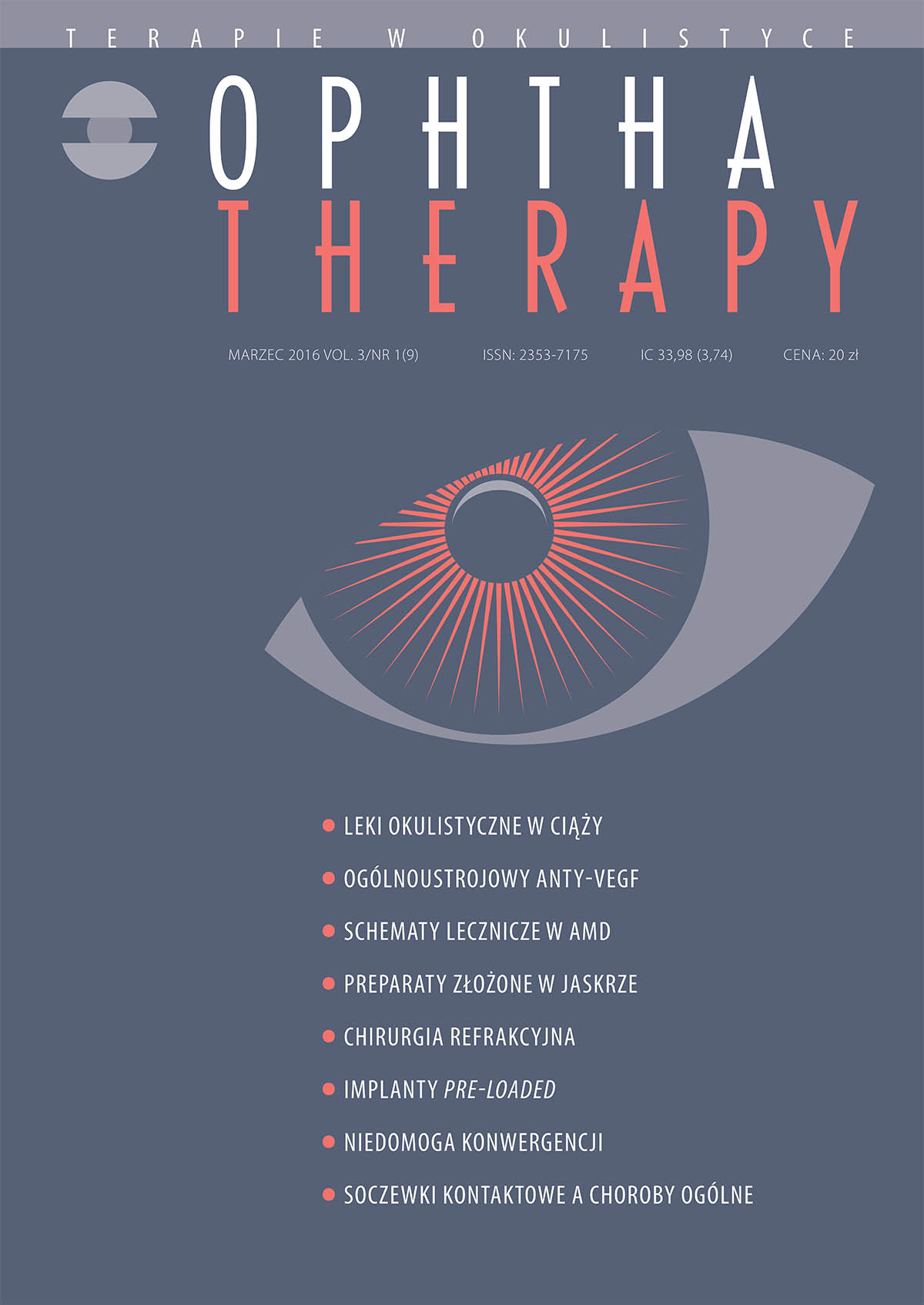Schematy leczenia wysiękowej postaci AMD – wady i zalety
##plugins.themes.bootstrap3.article.main##
Abstrakt
Terapia anty-VEGF jest obecnie standardem w przypadku wysiękowej postaci AMD. Stosowane leki to: ranibizumab (Lucentis), aflibercept (Eylea) oraz bewacyzumab (Avastin). Ten ostatni w okulistyce podawany jest off-label. Schematy leczenia są różne. Leki można stosować według sztywnego schematu, w zależności od potrzeby (pro re nata) lub w schemacie treat and extend.
Pobrania
##plugins.themes.bootstrap3.article.details##

Utwór dostępny jest na licencji Creative Commons Uznanie autorstwa – Użycie niekomercyjne – Bez utworów zależnych 4.0 Międzynarodowe.
Copyright: © Medical Education sp. z o.o. License allowing third parties to copy and redistribute the material in any medium or format and to remix, transform, and build upon the material, provided the original work is properly cited and states its license.
Address reprint requests to: Medical Education, Marcin Kuźma (marcin.kuzma@mededu.pl)
Bibliografia
2. CATT Research Group, Martin DF, Maguire MG, Ying GS et al. Ranibizumab and bevacizumab for neovascular age-related macular degeneration. N Engl J Med. 2011; 364(20): 189.
3. Gupta OP, Shienbaum G, Patel AH et al. A treat and extend regimen using ranibizumab for neovascular age related macular degeneration clinical and economic impact. Ophthalmology. 2010; 117: 2134-40.
4. Holz FG, Amoaku W, Donate J et al. Safety and Efficacy of a Flexible Dosing Regimen of Ranibizumab in Neovascular Age-Related Macular Degeneration: The SUSTAIN Study. Ophthalmology. 2011; 118: 663-71.
5. Klein R, Klein BE, Tomany SC et al. Ten-year incidence of age-related maculopathy and smoking and drinking: The Beaver Dam Eye Study. Am J Epidemiol. 2002; 156: 589-98.
6. Lalwani GA, Rosenfeld PJ, Fung AE et al. A variable-dosing regimen with intravitreal ranibizumab for neovascular age-related macular degeneration: year 2 of the PrONTO Study. Am J Ophthalmol. 2009; 148(1): 43-58.
7. Larsen M, Schmidt-Erfurth U, Lanzetta P et al. Verterporfin plus Ranibizumab for Choroidal Neovascularisation in Age-Related Macular Degeneration. Twelve-month MONT BLANC Study Results. Ophthalmology. 2012; 119(5): 992-1000.
8. Martin DF, Maguire MG, Fine SL et al. Ranibizumab and bevacizumab for treatment of neovascular age related macular degeneration: two-year results. Ophthalmology. 2012; 119: 1388-98.
9. Muether PS, Hermann MM, Viebahn U et al. Vascular endothelial growth factor in patients with exudative age related macular degeneration treated with ranibizumab. Ophthalmology. 2012; 119: 2082-6.
10. Pascolini JD, Mariott SP. Global estimates of visual impairment: 2010. Br J Ophthalmol. 2012; 96(5): 614-8.
11. Richard G, Monés J, Wolf S et al. Scheduled versus Pro Re Nata Dosing in the VIEW Trials. Ophthalmology. 2015; 122: 2497-503.
12. Rosenfeld PJ, Brown DM, Heier JS et al. Ranibizumab for neovascular age-related macular degeneration. N Engl J Med. 2006; 355: 1419-31.
13. Schmidt-Erfurth U, Kaiser PK, Korobelnik JF et al. Intravitreal aflibercept injection for neovascular age-related macular degeneration: ninety-six-week results of the VIEW studies. Ophthalmology. 2014; 121: 192-201.
14. Wong TI, Li X, Su X et al. The Number and Distribution of People with Age-Related Macular Degeneration Worldwide. ARVO. 2013: 220-00065.
15. Wykoff CC, Croft DE, Brown DM et al. Prospective Trial of Treat-and Extend versus Monthly Dosing for Neovascular Age-Related Macular Degeneration. Ophthalmology. 2015; 122: 2514-22.

